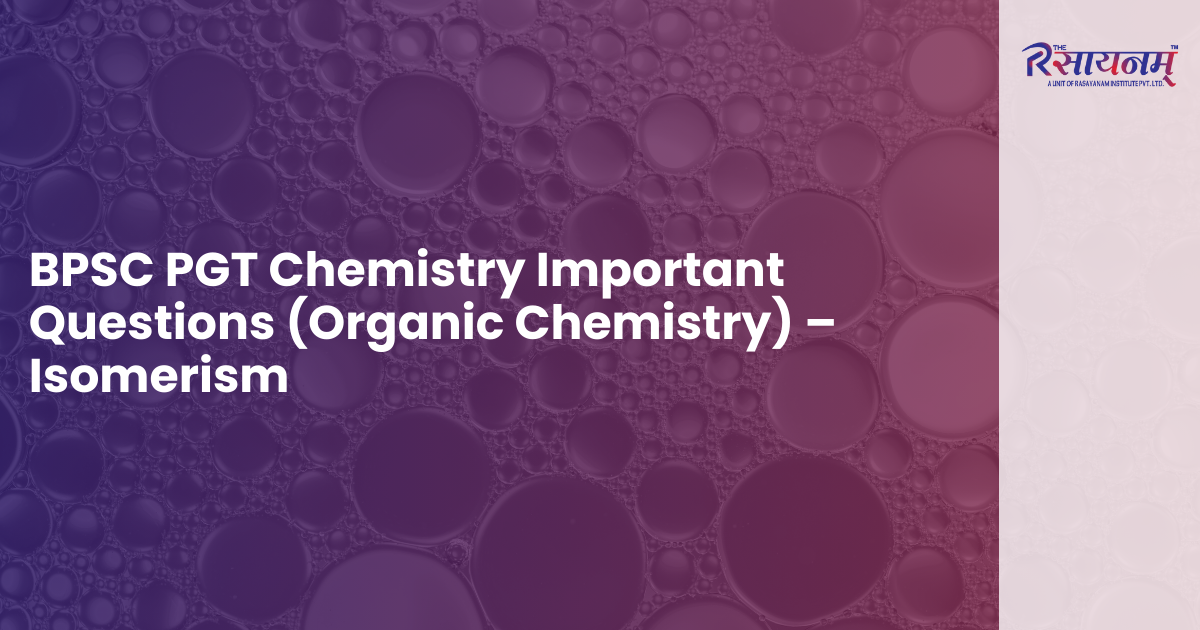
1. Enantiomers are same as diastereomers.
a) true
b) false
Answer: b
Explanation: In optical isomerism, enantiomers are non-superimposable mirror images of each other, while diastereomers are also non-superimposable but are not mirror images. Diastereomers differ from each other in both physical and chemical properties.
2. Optical isomerism is a type of ____________
a) metamerism
b) stereoisomerism
c) geometrical isomerism
d) tautomerism
Answer: b
Explanation: Compounds with the same molecular formula but different spatial arrangements of atoms or groups are called stereoisomers, and this property is known as stereoisomerism. It is classified into three types: optical isomerism, geometrical isomerism, and conformational isomerism.
3. The d-form is also known as ____________
a) rotatory
b) laevorotatory
c) dextrorotatory
d) l-form
Answer: c
Explanation: An isomer that rotates the plane of polarized light to the right (clockwise) is called dextrorotatory (d-form), while one that rotates it to the left (anticlockwise) is called laevorotatory (l-form).
4. 2-chloropropane and 1-chloropropane exhibit ____________ isomerism.
a) chain
b) position
c) functional
d) metamerism
Answer: b
Explanation: Compounds that share the same molecular formula but differ in the position of a functional group or substituent are called positional isomers, and this phenomenon is known as position isomerism. For example, 1-chloropropane and 2-chloropropane differ in the position of the chlorine atom, hence they are positional isomers.
5. Which of the following is not a type of structural isomerism?
a) geometric isomerism
b) chain isomerism
c) metamerism
d) tautomerism
Answer: a
Explanation: Structural isomerism occurs when compounds have the same molecular formula but different structures. It is further classified into chain isomerism, position isomerism, functional isomerism, metamerism, and tautomerism. Hence, geometrical isomerism does not fall under structural isomerism.
6. If a compound has 3 chiral carbons What is the number of optically active isomers?
a) 9
b) 3
c) 4
d) 8
Answer: d
Explanation: The number of optically active isomers of a compound is calculated using the formula 2ⁿ, where n is the number of chiral carbons. Since this compound has 3 chiral carbons (n = 3), the total number of optically active isomers is 2³ = 8.
7. How many planes of symmetry does a meso compound have?
a) 2
b) 1
c) 3
d) 4
Answer: b
Explanation: A meso compound is one in which one half of the molecule is a mirror image of the other half. Such compounds usually contain two or more chiral centers and possess a plane of symmetry. Meso compounds are optically inactive because of internal compensation.
8. What is the specific rotation if its observed rotation is given as 3x, its length is given as x and density is given as 3/y?
a) 2y
b) 3y
c) y
d) 4y
Answer: c
Explanation: The formula for specific rotation is:
[α]=Observed rotationlength × density[\alpha] = \frac{\text{Observed rotation}}{\text{length × density}}[α]=length × densityObserved rotation
Here, the observed rotation = 3x, length = x, and density = 3/y.
So,
[α]=3xx×(3/y)=y[\alpha] = \frac{3x}{x \times (3/y)} = y[α]=x×(3/y)3x=y
Thus, the specific rotation equals y.
9. Acetaldehyde and ethenol show ____________
a) stereoisomerism
b) metamerism
c) positional isomerism
d) tautomerism
Answer: d
Explanation: Acetaldehyde and ethenol show tautomerism, a special type of functional isomerism found in carbonyl compounds with an α-hydrogen atom. It involves the interconversion between the keto form and the enol form.
10. A compound with the same molecular formula exists in two forms one is alcohol and the other is Ether, what type of isomerism does it show?
Answer: c
Explanation: Functional isomerism occurs when compounds have the same molecular formula but different functional groups. For example, C₃H₆O can exist as an aldehyde or a ketone. Similarly, the given compound can exist as an alcohol or an ether, showing functional isomerism.
Related Question Bank to Read:
BPSC PGT Chemistry: p-Block Elements Important Questions
BPSC PGT Chemistry Important Question: Uses of Boron and Aluminium and their Compounds
BPSC PGT Chemistry: Trends and Anomalous Properties of Boron Important Questions
BPSC PGT Chemistry: p-Block Elements Important Questions
Silicon & P-Block Elements: Understanding Their Properties and Applications
Boric Acid & P-Block Element: Understanding Their Properties and Applications
BPSC PGT Chemistry: Important Compounds of Boron
 Download The Rasayanam App
Download The Rasayanam App

Also, download our brochure for more details on the program and contact us with any queries.
Conclusion
If you’re preparing for BPSC PGT Chemistry, The Rasayanam provides structured courses, expert mentorship, and top-quality study resources to help you excel.


